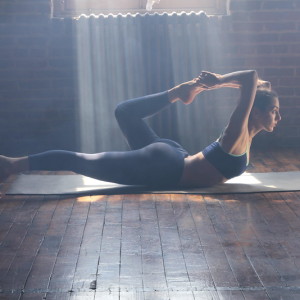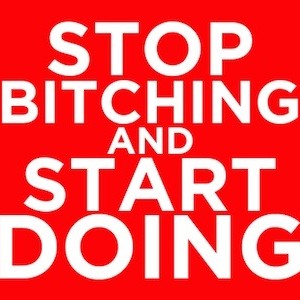6 Ways to Tell if Your Favorite Celebri-Yogi Teacher Can Actually Teach ~ Maya Devi Georg
You’ve saved your pennies to attend the latest conference, mainly to take a class with your favorite celebri-yogi teacher.
This celebrity teacher may have been featured on the cover of a magazine, or in glossy advertisements; you subscribe to their YouTube channel, and can feel their charm and enthusiasm right through your laptop. They inspire you with their advanced asanas, their plucky attitude, and, gosh darn it- they’re just so damn cute!
But can they teach?
You attend their workshop and await transformation, in your asana and personal practice. The excitement and expectation is overwhelming. And, sometimes, the hype can pump us up, and leave us blind.
Teaching is an honor, and it should be about the student and their practice. It should not be a performance centered on the teacher, exalting their practice. A teacher’s ability to perform an asana is irrelevant if they can’t show you how to get there.
Here are a few traits I believe are absolutely necessary in an adequate teacher (both celebri-yogi and local). And a celebrity teacher should be more than adequate; they should be stellar:
Are they Accessible, Available, and Present?
I’ve seen many a celebri-yogi enter a class like a rock star; arms waving, thanking the crowd, making a sweeping statement about the class or workshop then jump right into the practice. I admit, the grand entrance looks like a lot of fun. But, a great teacher should try to meet as many of the participants as possible, learn names, and give the students a chance to let them know about injuries or health concerns.
Those that make the grand entrance, also make the quick getaway. This allows the teacher to actually leave in a timely manner, and avoid stupid questions (yes, they exist—I was in a workshop with a celeb yogi and a student asked to see his abs). But, if you have any relevant questions or comments regarding the practice, you are left to figure them out on your own.
To be fully present while teaching means having the ability to spot an injury, and offer an alternative posture; to see questions in the eyes of students and give them the space and permission to approach and ask freely. This is very difficult to accomplish in huge workshops, but not impossible. A great teacher must be mindful and aware of what is happening in the room around them.
Do they make adjustments—both verbal and physical?
I love adjustments, they help me feel asanas in new ways, help me deepen the pose, and find new expressions of it. Dharma Mittra could shoot me a look across a crowded class and I would suddenly move deeper into the posture. Doug Swenson spotted me in an inversion, and I immediately understood what had been eluding me in the balance. I’ve been man-handled, jumped on, pulled and pushed into poses. And I loved it!
Of course these were experienced teachers, with years of wisdom and understanding of what was appropriate, but even new and young teachers have surprised me with gentle yet effective adjustments.
A teacher that simply avoids adjustments and corrections is allowing students to continue in their practice incorrectly. And that is, at best, inattentive and unprofessional—no matter the excuse.
Have they given clear verbal direction?
Some teachers can talk! But are they saying anything? A five minute explanation of Virabhadrasana I might be necessary for an absolute beginner, but in a workshop or conference setting full of experienced practitioners, it is just noise. The simplest explanations are best, and sometimes that is just naming the pose.
I can recall my first headstand. It was in a local class with a non celebri-yogi. She managed to talk the entire class through the process effectively, without demonstrating, but carefully watching. I was amazed. First that I actually managed to stand on my head, and also by the clear and simple directions I was given.
I recently attended a workshop from an up and coming celeb yogi that talked the entire class into a handstand without any warning. There I was in a down dog and she simply stated “raise one leg,” then “kick up.” For those that do not know me, I have injuries that limit the range of motion in both wrists. Handstands are simply not physically possible for me at this time.
I was not the only upset participant in the class. Had the teacher let the class know what pose was next or at least instructed through a few options, the students with any concern could have done an alternate posture.
Are they setting you up for greatness? Or failure?
While it is difficult to ensure that every student is warmed up and ready for every pose, teachers should always do preparatory asanas before introducing a pose that requires significant flexibility. Aside from eliminating risk of injury (and subsequent litigation), this simply makes those challenging poses more accessible. And that’s why we continue to take classes, travel to workshops, study texts and read articles: to learn and grow, to understand the practice better and make it a bigger part of our lives!
But accessibility extends beyond the physical…I have had teachers encourage me, cheer me on, and get excited when I reached asana milestones. And when I didn’t get to the goal, the assured me that with persistence I would.
In a recent class I attended, I had a teacher pause and say: “Don’t let yourself get freaked out by this next pose.” It had the opposite of the intended effect, and all I could feel was the energy in the room sink.
Teachers have multiple roles: Coach, Mentor, Cheerleader, and every now and then, (unlicensed) Psychotherapist. The teacher must encourage students to progress and challenge themselves so that the student may grow—and its as much mental, emotional, and spiritual, as it is physical.
Is the class balanced?
Unless the class or workshop is labeled as something very specific, it should contain a variety of poses. An unnamed workshop that consists of nothing but standing strengthening poses is both exhausting and boring. A specialty workshop without a significant number of counter poses can leave you feeling crippled.
An excellent teacher can balance strength and flexibility, as well as the energetics of yoga asana into a workshop. By energetics I refer to both breath and prana. A great teacher can awaken a heightened awareness of the subtle body, and make your asana practice into spiritual experience.
Are they prepared?
I’ve seen it all: The teacher carefully planning each sequence so that the impossible pose we were working towards was actually accessible; the perfect playlist, rising to a crescendo as the peak pose is performed; the balance of pose and counter-pose. All these traits coming together and demonstrating deep wisdom, and great care for the students.
I’ve also seen the dark side of the celebri-yogi—paying more attention to their iPod and playing DJ than to the 50+ students in the class (you couldn’t create a play list in advance?); the teacher repeating the same sequence two or more times for no discernible reason (the workshop has been scheduled for nearly a month and this is all you could come up with?).
In my humble opinion, this shows outright disrespect for the students, their money, and their time.
The purpose of taking a class with a teacher is to get some level of personal attention. While that may be difficult in a class of 60 students, it should not be impossible. So many great teachers arrange for assistants to help monitor and assist large groups of students. These are usually great teachers themselves, and you can look forward to eventually see them on the conference and workshop circuit!
The seduction of celebrity can be blinding.
Anticipation and expectation can rob us of our ability to see things as they are. Both teachers and students need to cultivate discernment in order to maintain a high level of quality. As a student and teacher I hope to meet all of these standards in the classes I myself teach. If this quality is not being delivered, just get the celebrity yogi’s DVD (you’ll get the same amount of attention from the DVD as from the teacher).
Or, better yet, seek out one of the excellent teachers in your area who does all the things I listed above! They may not be producing their own DVDs or appearing on the covers of magazines, but they have dedicated themselves to continually learning, growing, and serving their students.
This country has so many fantastic teachers who no one outside of their studio or town has ever heard of, and, to me, they are the true rock stars.




